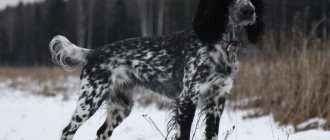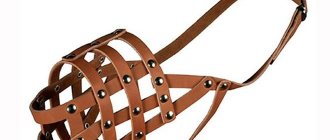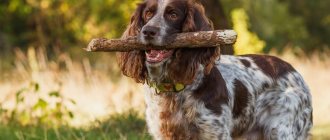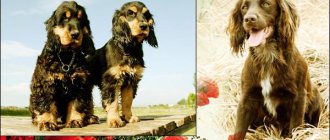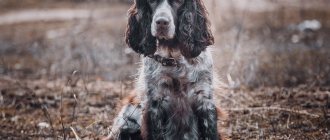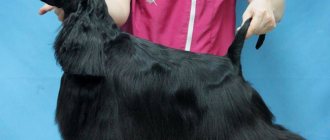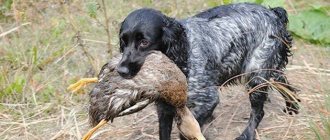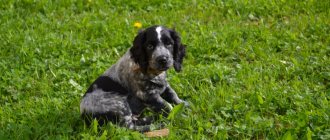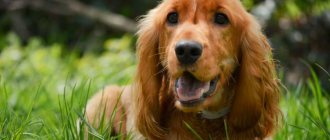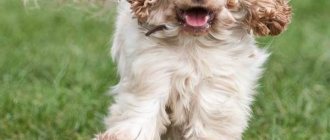- Breed name: Russian Spaniel
- Country of origin: Russia
- Time of origin of the breed: in the second half of the 20th century
- Weight: males and females (minimum 13 kg)
- Height (height at withers): males (minimum 38 cm), females (minimum 36 cm)
- Lifespan: 12 to 14 years
Author of the article
Tatyana Anisimova
Breeder of purebred dogs with 12 years of experience.
Ask a Question
Breed characteristics
| Short description | |
| Origin: | Russia |
| Conditions of detention: | House with or without garden, apartment |
| Purpose: | Hunting dog, companion dog |
| Color: | Solid solid black, tan or chocolate brown, white markings acceptable |
| Wool length: | Long |
| Adult dog size: | Female height – 36-42 cm, male height – 38-44, weight – 15-20 kg |
| Average life expectancy: | 10-12 years |
| Walk: | Need active walking twice a day |
| Physical activity needs: | High physical activity needs (1.5-2.5 hours of walking or training) |
| Classification of the Russian Cynological Federation (RKF): | Group 8: Retrievers and Gun Dogs, Section 2: Gun Dogs |
| Puppy price: | From 3,000 to 20,000 rubles. Without pedigree – 3000-5000 rubles, pet class – 10000 rubles, breed class – 15000 rubles, show class – 20000 rubles |
History of the origin of the species
The idea to develop a new hunting breed came to Russian breeders at the end of the 19th century, when European Spaniels, which were good at hunting, but were not suitable for the climate, began to be imported into the country. Active work began, the long-legged Cocker and Spring Spaniels were crossed.
The Russian Spaniel is considered one of the youngest Russian hunting breeds. The breed took its final form in the mid-20th century; a standard was developed in 1951 1966 . But before this, the breed line was not perfect. Dogs no longer resembled their ancestors, but still did not constitute a single new type. Since 1972 , dogs are no longer modified.
The animals are still not recognized by the International Canine Organization, although in Russia they are highly valued for their versatility. Russian spaniels hunt any feathered game, hares and small fur-bearing animals.
Pros and cons of the breed
Advantages of Russian Spaniels:
- The dimensions allow you to keep the animal in apartment conditions, as well as transport it in a bag on public transport.
- High intelligence.
- Easy to learn.
- A small percentage of genetic abnormalities.
- The presence of hunting instincts in the blood.
- Compatibility with other animals.
- Good attitude towards children.
- Devotion to the owner.
The disadvantages include:
- The difficulty of hunting in difficult conditions. In tall grass, a spaniel quickly loses strength.
- Inability to keep exotic rodents and birds together, which will be perceived as prey.
- Hyperactivity of young individuals.
- Proneness to ear infections due to the structure of the ear.
Distinctive features
This breed is medium-sized, well-built, with a strong body and well-developed muscles. A feature can be considered long hair and variability of colors. At the withers, the animals reach 36-44 cm, and weigh from 15 to 20 kg.
Spaniels are stretched in structure. Their body length is slightly greater than their height. Their limbs are quite long, which makes them adaptable to running through swamps or snowdrifts. The latest standard was published in 2012.
- The head is dry and long. The skull is oval, with a pronounced smooth stop and brow ridges.
- The muzzle is moderately long, narrow (tapering towards the nose), filled in under the eyes. The jaws are strong but soft, with a full set of teeth and scissor bite The lips are thin and pigmented.
- The nose is wide with open nostrils.
- The eyes are medium-sized, oval, not widely set. The color of the iris depends on the coat color: from light brown to dark brown.
- The ears are set at eye level, long, thin, adjacent to the cheekbones;
- The body is streamlined and strong. The back is long and wide. The loin is slightly convex. The croup is sloping. The withers are pronounced. The chest is deep and well descended. The neck is of moderate length, dry, muscular. The belly is tucked in.
- The tail is a continuation of the croup, moderately long, carried at the level of the back or slightly above it. It is docked by half, unless it is prohibited in the country.
- The limbs are dry, straight, parallel, the hind legs are set wider than the front ones. The paws are oval with gathered toes, characterized by the presence of hair between them. Movement : light gallop.
- The coat is straight or wavy, moderately long, close-lying and shiny. Lengthening is noticeable on the ears, limbs, abdomen, chest and neck.
- Colors: solid, bicolor or tricolor in various variations.
Grooming, trimming English Cocker Spaniel
Correct grooming procedures: hygienic grooming (see above), stripping and carding, bathing and combing, light edging and filing.
Grooming practices used in pet grooming: machine cutting. If you are trimming a spaniel
, then do this before swimming, using trimming powder and rubber gloves/finger pads. It is ideal if you use the hand stripping technique (plucking dead guard hairs with your hands), taking into account breed standards, skeletal structure and muscle lines (see pic). And also, without fail, carding is used (combing out the dead undercoat) so that the fur subsequently fits tightly to the body. Procedures are carried out in the head, neck, back, croup, hips (see figure). If, after trimming and bathing, the wool in the indicated areas continues to bristle, then you can thin it out as it grows using thinning scissors or a special attachment on the machine, lifting the wool with a comb.
If you are cutting a spaniel
, then do it in the same way as trimming and, preferably, in the direction of hair growth. Carding after a haircut won't hurt either.
Whatever grooming technique you choose, do not forget that the transition from short to long hair should be imperceptible! Please note that in show grooming the hair on the back of the front paws is kept natural, while on the front of the front paws the hair should be short. On the back of the thighs the hair should hang down but be separated from the tail. On the head and muzzle, the hair should be short and close to the skin. If there is overgrowth, then the muzzle is trimmed with a clipper, and the long hair on the head is stripped or also removed with a clipper. On the throat, the hair is removed short in the shape of a U. The ears are trimmed on the outer side to the top 1/3, on the inside - the hair is removed from the ear canals and about 1/2 of the upper part of the ear.
Photo of an adult dog
Photos of puppies
Features of character and behavior
The Russian Spaniel is an excellent pet and companion. He is active, friendly and devoted to his owner. The breed has not lost its hunting qualities and still serves people.
These dogs are characterized by intelligence and ingenuity, independence in decision-making, good reaction, and endurance. All these qualities become indispensable in the forest.
Advantages
The breed was bred for hunting, so it has a full range of necessary physical qualities:
- Acute vision and sense of smell;
- Energy;
- Endurance;
- Resistance to cold and dampness;
- Strong skeleton and developed muscles.
Animals learn quickly and understand all commands.
Russian spaniels love their family, get along with children, and listen to their owner. They will be happy to serve a person, spend all their time with him: lying on the couch or climbing into a cold swamp. They like to run with their owner, play with family members, and bring toys. These dogs are very active and remain playful almost into old age.
They get along well with other pets and livestock. They communicate well with both dogs and cats, despite the fact that they are hunters.
Flaws
- Spaniels can be stubborn, intractable, and often try to dominate.
- They really need good upbringing and a firm hand, otherwise they will grow up to be an uncontrollable pet.
- They are real destroyers: they love to gnaw, break, tear, scratch. Everything that lies badly will be picked up, studied and spoiled by this pet.
- They cannot serve as guards. Representatives of the breed are friendly and do not see danger in humans. Besides that, they just bark.
- They are gluttonous and have no sense of proportion. This makes walking much more difficult. If the bad habit of picking up from the ground was not eliminated during puppyhood, then you can forget about walking without a leash.
- They can be aggressive towards other people's children and do not like noise, shouting and bullying.
Training and education
The Russian Spaniel is easy to train. He follows the commands given to him by his owner well. After praise, he performs the learned commands with joy. Training begins with basic commands:
- "Sit!";
- "Lie!";
- "To me!";
- "Near!".
After mastering them, you should begin training in discipline, which plays a big role for successful hunting. These skills should begin to be taught at three months of age. Since participation in hunting is an innate skill, you won’t have to face any special difficulties.
Advice! No need to yell at the puppy. You should communicate calmly, even if he has not immediately mastered the training.
First you should learn the command “Give it!”. Moreover, you should train not with a ball, but with a lump of feathers or a bird’s wing.
Sequencing:
- Give the puppy the command “Sit!”
- Give him a bird's wing in his teeth.
- Give the order “Give” and pull the wing towards you, while holding the treat in sight.
- Increase the distance by moving the wing further.
- Start executing the “Search!” command. To do this, they are first taught to look for the hidden treat, and then the wing itself.
- When found, give the command “Give it!”
If training is done outdoors, then the command “Give!” practiced by throwing an object into water. Innate instinct will help the puppy quickly learn to retrieve it. When training in the forest, the command “Come to me!” must be accompanied by the sound of a whistle, since the dog can run far in search of prey.
Recommendation! It is better not to use the Russian Spaniel when hunting in bushes and dense thickets, as this will quickly exhaust him.
The Russian Spaniel is devoted to only one owner, so the owner must educate himself. No special knowledge or skills are required, since the spaniel, in addition to its innate instincts, is flexible.
Care and maintenance
These dogs can be kept both indoors and outdoors. They feel comfortable in various conditions and can tolerate any temperature. Of course, like every hunting dog, the Spaniel will be happy to spend all his time outside, where he can chew, sniff, and search.
If you plan to keep an enclosure or kennel, then you need to provide the dog with warm bedding and a strong canopy that will protect it from sunlight and precipitation. The puppy will also need a tray for the primary toilet, toys and bowls on stands.
Apartment housing is no different from street housing, but the dog will need less food. You need to choose a place for your pet that is free from sunlight and drafts; the closer to the owner, the better.
In general, these animals are unpretentious. They do not require careful care, they eat what they give. But they need to be provided with frequent regular walks, exercise and brushing.
Nutrition
Spaniels are hunting dogs that need a lot of energy and strength, so their nutrition must be complete. More and more breeders prefer dry food, despite its bad reputation. The fact is that finished products are much easier to store and use, they contain a complex of necessary substances for dogs, in addition, separate lines have been developed for active and sedentary, sick pets, allergy sufferers, pregnant and lactating bitches.
Poor quality food may contain unnecessary substances that complicate digestion, have a negative effect on organs, and contribute to excess weight gain. Spaniels are suitable for premium holistic (grain-free) food for active medium-sized breeds.
We recommend that you read a detailed article on the topic: “How and what to feed a dog: types and characteristics of nutrition.”
These pets are prone to obesity, so the amount of food should vary depending on the activity of the animal.
On average, an adult spaniel needs 400-600 grams of food diluted with water per day. In summer, the portion is reduced, and in winter it is increased. Puppies up to 3 months are fed 5-6 times , up to 6 months - 3-4 times , and by the year they switch to two meals a day.
Usually the nursery gives advice on keeping and feeding the puppy. The breeder recommends a specific type and brand of food, the one the dog was fed before purchase. If the owner is planning a transition, then this should be done smoothly: feed the pet with the products included in the composition or choose a similar food.
For this breed, you can choose natural feeding. It is healthier and better absorbed, and the owner knows what exactly he is giving to the pet. The downside is the time spent and the inconvenience of storage and use.
The basis of the menu of such a diet should be protein:
- Lean meat;
- Dairy products;
- Boiled sea fish without bones;
- Eggs.
Don't forget about carbohydrates: grains, cereals. The dog must be accustomed to vegetables and fruits.
The menu should not include:
- Butter;
- Legumes;
- Starchy vegetables and fruits;
- Bones;
- Pork;
- Citrus;
- Flour and confectionery products;
- Smoked, fried and fatty.
Your pet's food should be of medium temperature and medium consistency. Puppies are given more food than adults. From 5-6 months you can give large pieces for chewing. Mixing dry and natural food is not allowed .
Low-fat cheeses and special treats from the pet store are suitable as treats.
It is important to maintain a drinking regime. In summer, the volume of water needs to be increased. It is important not to forget to take a container of drink for a walk.
Health
This breed can be considered truly Russian. Its representatives are not afraid of frost, work and changes in living conditions. These Spaniels are in good health, they live from 10 to 12 years , with ideal care 13-14 years . But like all long-haired, long-eared hunting breeds, they are prone to skin diseases, ear problems and digestive problems.
In addition, dogs are at particular risk of contracting an infectious disease. Therefore, you should not neglect vaccination.
Vaccinations
Hunting dogs are in dire need of vaccination because they deal with wild animals, which are often carriers of diseases. Even if the dog is not walked, vaccinations must be done, since a person can carry viruses on his clothes.
Vaccination does not provide 100% protection against infections, but it prevents their development and helps the pet recover from infection. Unfortunately, unvaccinated puppies will die if they become ill.
Usually the nursery does the primary vaccinations, and the breeder prepares the necessary documents, including a veterinary passport. The owner will be informed of the vaccination schedule that must be followed.
- The first procedure is carried out when the puppy reaches 2 months . At this time, the immunity given to him by his mother stops working. The drug is complex and contains a vaccine against major infectious diseases, such as plague and leptospirosis.
- The vaccination is repeated at 2.5, 6, 12 months and annually.
- The second important vaccination is against rabies. The drug is administered to a seven-month-old puppy. The procedure requires annual updating because it loses its effect. This vaccination is considered the main one for exporting an animal abroad.
Two weeks before vaccination, the dog must be dewormed. Before the procedure, the pet’s temperature is measured; the normal value (37-39°C) should not deviate.
Vaccination is carried out by specialists at equipped points. In case of an allergic reaction, the animal is given an antidote. If negative side effects occur for more than a day, you should consult a doctor.
The cost of vaccination depends on the weight of the pet and the percentage charged by the veterinary clinic. Usually it varies from 400 to 1000 rubles.
Important article on the topic: “Everything you need to know about dog vaccinations.”
Diseases
Health problems that are most common in this breed include:
- Skin diseases: dermatomycosis (lichen), piroplasmosis (a disease carried by mites), demodicosis (mites getting into hair follicles), sarcoptic mange (scabies);
- Diseases of the digestive system: obesity, allergies, indigestion;
- Inflammation of the ears, otitis media;
- Epileptic seizures.
Walk
This breed is extremely active. Dogs show it both at home and on the street.
With insufficient training and physical activity, the Spaniel will destroy the house: gnawing, breaking, carrying furniture and things. An adult dog needs an active walk twice a day for 1.5-2 hours.
Walking can begin after the second vaccination. The puppy is carried out in their arms and introduced to nature. After 2-3 weeks, you can learn to walk on a leash. Small dogs are walked 3-4 times a day for 20 minutes. They must get used to their environment and strangers.
The next step of socialization is getting to know other animals. Spaniels get along well with dogs and love to play with them, but the owner should always focus the pet's attention on himself. The puppy should know that it is always more interesting with a person.
The final stage will be walking the animal in noisy, crowded places . This is necessary so that the adult Spaniel is not afraid of sharp sounds, large moving objects, or passers-by. An unsocialized dog can become timid or aggressive.
For an adult pet, hunting will be an excellent walk and exercise. If it is not possible to organize a real one, then you can take the dog to the forest or planting, where it can show all its best qualities.
Spaniels make good partners for running and other sports activities. They love to play ball, fetch sticks, and chase bicycles.
Grooming
In caring for a Spaniel, the following main points can be distinguished:
- Combing must be done at least 2-3 times a week, and during seasonal shedding, daily combing with a stiff brush is required;
- bathe your pet no more than 2-3 times a year; the coat of these dogs has a protective barrier against pollution and does not emit unpleasant odors;
- If the pet is not a show pet , haircuts are allowed (2-3 times a year);
- After walks and when heavily soiled, dogs are wiped with a damp towel and their paws are washed under warm water;
- The ears are considered the weak point of all Spaniels; they are poorly ventilated due to their specific shape; they must be examined daily, checking for the presence of inflammatory processes;
- Teeth are checked twice a week, brushed with special pastes or chewing cords;
- The claws usually grind down on the asphalt; if they grow too long, they require trimming with a nail clipper once a month;
In the warm season, treatment against fleas and ticks using shampoos, solutions, powders or a collar is mandatory. Every 2 months a deworming procedure (cleansing from worms) must be carried out.
Health of the Russian Spaniel
Like other dogs, representatives of the breed are susceptible to infectious diseases. The most common illness is an acute infectious disease that affects the liver, kidneys and muscles. The dog also suffers from ringworm, toxoplasmosis and various parasites.
Inflammatory processes such as otitis media occur in the ear openings. Most often, they affect individuals who periodically swim in open water. In addition, the animal suffers from obesity as a result of increased food allergies.
Mating
Dogs can be untied at the age of 20-25 months, although puberty comes much earlier (8-10 months). It is during this period that the female will go into her third heat, and a loose loop and light discharge will be a signal that the girl is ready.
To officially transport the breeding, owners need to fill out certificates and forms at the nursery. The male is selected in advance, the owners agree on the date and price, which is usually equal to one puppy or a percentage of its cost.
Pets must be checked for pathologies and diseases and undergo deworming 2 weeks before mating.
Spaniels are not large, they do not need much space. The pets are introduced, walked together, and brought to the dog’s territory. Here the boy will feel relaxed and free. If the female is calm and everything suits her, then the male will be able to make a cage. Otherwise, you need to give the dogs more time or try another day.
Sexual intercourse lasts from 10 to 15 minutes , during which time the animals are helped not to lose their balance: the girl is held under the stomach and by the head, the boy is guided into a noose. You can invite a specially trained person. In the absence of a lock, the female can be fertilized. The fixative mating is carried out after 2 days .
Read a detailed article on the topic: “Everything you need to know about breeding dogs: appropriate age, what to do if it doesn’t work out, rules and tips.”
Key points in training
A Spaniel puppy chooses one owner to obey. But for this, a person needs to show his leadership qualities and show the dog the existing hierarchy in the family.
In order for your pet to understand that the people in the house are the main ones, you need to teach him some habits:
- Feeding is carried out only after the whole family has eaten;
- You can enter the room only after everyone has entered;
- Walking, sleeping, and playing on human furniture is strictly prohibited.
Representatives of the breed tend to dominate. All attempts to dominate or show character must be stopped. However, crude methods will not work. Enough with a stern look, a firm word, and deprivation of treats.
The owner needs to learn not to react to begging, puppy dog eyes, and acting techniques.
Raising a dog begins from the first days of life, but training begins from 3-4 months , when the puppy remembers its name. You can contact the kennel club and take the “Dog in the City” course. It will help the dog socialize and the owner to establish contact with the animal.
For a hunting dog, it is important to unquestioningly follow basic commands:
- "Near";
- "To me";
- "It is forbidden";
- "Sit";
- "Voice".
Read about how to properly train a dog in the article: “Training a puppy: effective methods from dog handlers, learning commands at home.”
If the owner has not achieved obedience, the pet is unlikely to become a good helper. To train individual hunting skills, it is worth contacting specially trained people.
Nutrition
Any future owner of a Russian hunting spaniel should remember that the dog is characterized by an accelerated volume of substances. Therefore, it is permissible not to feed twice a day, as is the case with most breeds, but three times a day.
Russian hunting spaniel with a trophy returns to its owner
At the same time, the quality of food is important - its composition and protein-carbohydrate fat balance. If the dog receives natural products, then the diet must contain minerals and vitamin supplements.
Proteins that are preferred for animals include: sea fish, meat, liver and dairy products. Carbohydrates include not only potatoes and pasta, which are prohibited for some breeds, but even flour products.
All this will help fill the dog with the energy it really needs. Different fats are important – both plant and animal. The dog will not be against vegetables and fruits either. But the requirements will automatically be simplified if the owner chooses premium-segment factory feed.
Russian Hunting Spaniel puppies require six meals a day. A rich meat broth into which you can chop vegetables and bread is ideal. It is even acceptable to add salt at the tip of the knife.
Russian hunting spaniel follows the scent
But it is better to give meat only in processed form, such as minced meat. But an older dog can be offered whole pieces, both raw and boiled, but it is important to separate the product from the bones.
How to choose a puppy
The choice of a puppy depends entirely on the financial capabilities and wishes of the potential owner. You need to decide on the gender of your pet. Males are better suited for hunting, but they are more capricious. Bitches are usually softer and can give birth.
In addition, it is worth choosing the puppy’s class in advance. Not only the dog’s future career depends on it, but also its cost. There are 3 classes that are assigned to an animal a couple of months after birth:
- Pet class - dogs with minor deviations that do not prevent them from becoming good pets;
- Breeding class – animals with ideal external characteristics, fully complying with the standard, suitable for breeding;
- Show class - pets with a good pedigree, born champions and prize-winners, their future career is exhibitions.
A puppy can be purchased at the age of 2.5-3 months. Small dogs are easier to train and adapt to their needs. But there is a lot of trouble with them, including vaccinations and special feeding. Experienced dog breeders prefer to buy older animals (5-6 months), but in this case problems with training may arise.
A good breeder will provide a package of necessary documents, tell you about the litter and parents, and help you decide on your future pet. The kennel has the right not to sell a dog if the potential owner does not meet the criteria or is not suitable to raise the dog .
Puppies will always be playful, perky and active. Healthy dogs must be clean, meet the standard and have no obvious pathologies. The cost depends entirely on the class of the pet: from 3,000 to 20,000 rubles .
Prices
The price of a Russian hunting spaniel is by no means exorbitant. The lower threshold is about 10-15 thousand rubles. The upper limit is limited to a maximum of 100 thousand rubles. But usually “dews” are much cheaper and are purchased for double-digit sums.
Before deciding on the purposes for which you are buying a dog - for yourself, for business and breeding, and maybe for mating, and for participation in exhibitions - it is important to know in advance what gender the dog will be. There are several differences that make male dogs stand out. They are more powerful and durable. At the same time, female dogs are considered more obedient and trainable, and are easier to train.
By the way, with this breed there is a case when it does not matter what the age of the dog that the nursery of Russian hunting spaniels offers. Of course, it is ideal to take a puppy. But an adult dog will also not experience problems with adaptation.
Do not forget that any nursery must also attach papers confirming the presence of a pedigree to the animal itself. She is the guarantee that your four-legged friend will be strong and healthy and has good genetics. When choosing a place to buy a dog, you should turn to the national club, under whose patronage a large number of kennels operate throughout Russia.
Reviews from breed owners
Reviews about the breed are mostly positive . Owners describe Spaniels as loyal and obedient hunting dogs, but believe they are not suitable for everyone.
- The first disadvantage is excessive activity and the need for frequent long walks.
- The second is a lot of wool.
- The third is diseases.
Thus, the owner of an adult Spaniel, Irina, writes: “These pets are unpretentious in their maintenance, survive frosts well, and eat everything. Very bright both in appearance and in character. They are loving, affectionate, playful, and are completely devoted to serving their owner. Indispensable during hunting. But they need careful care, especially for ears and fur. Dogs are very active and can be destructive. Without education, they become leaders in the family.”
Another owner believes that all dogs are worthy of attention and respect, but Russian spaniels are special: “You immediately fall in love with the eyes of this pet. You may not like animals, but a dog of this breed will win your heart. Our pet is loyal, playful, active. The only genetic drawback is frequent illnesses and epileptic seizures.”
Grooming and trimming of the American Cocker Spaniel
Correct grooming procedures: hygienic grooming (see above), carding and hand stripping, edging General grooming practices: machine cutting The dog's coat should lie smoothly on the head in the throat, neck, shoulders, back, sides and hips. Longer feathering on the ears, chest, along the lower contour of the body (skirt), on the back of the paws. Just like the English Cocker Spaniel, you should choose trimming or machine grooming, the principles of work are very similar. But, in any case, both procedures are carried out according to the main breed lines (see figure), taking into account the structure of the musculoskeletal system, and they are different for English and American cockers.
Considering that the American Cocker Spaniel has thicker and longer hair than other spaniels, pet grooming can use lighter versions of haircuts to make caring for a dog that does not attend exhibitions easier. This is undoubtedly more practical, see diagrams
